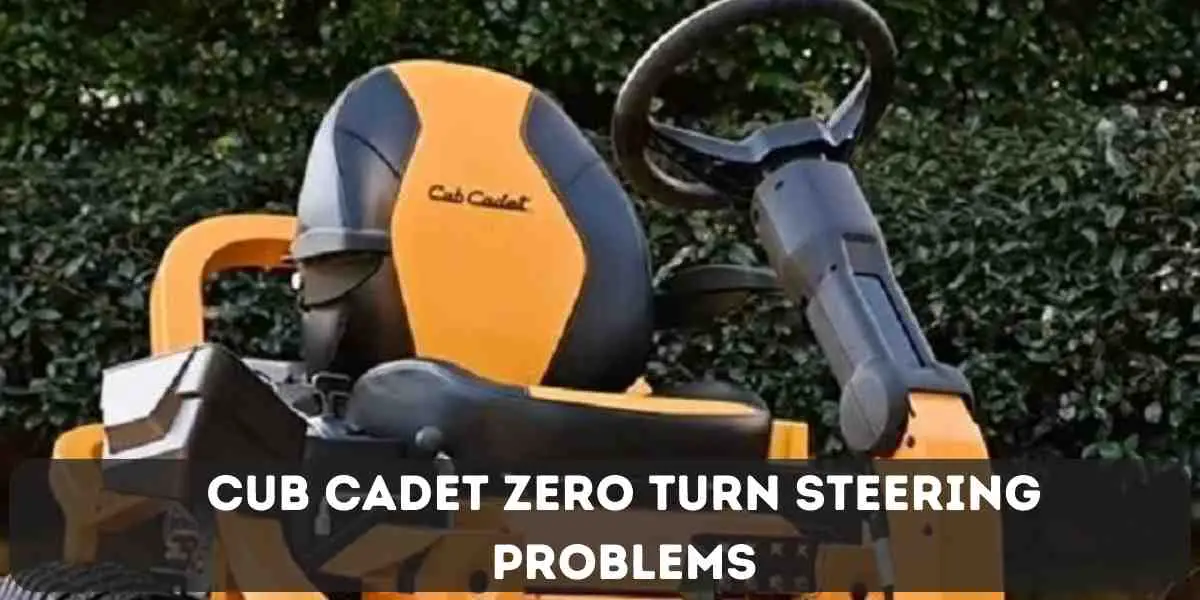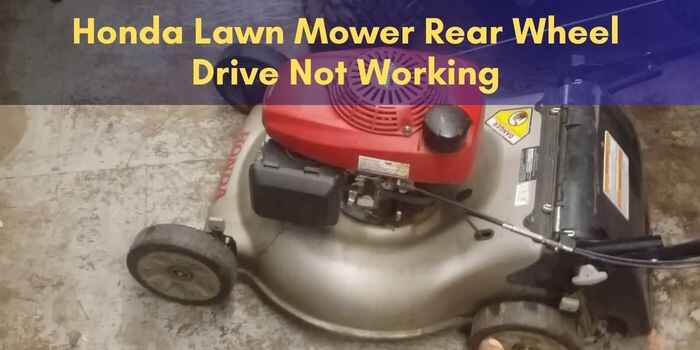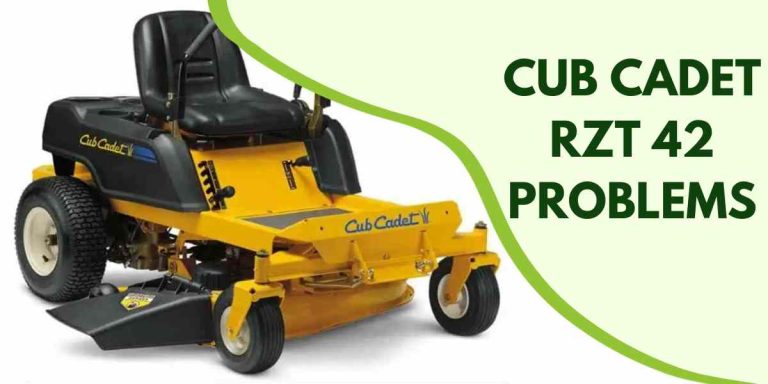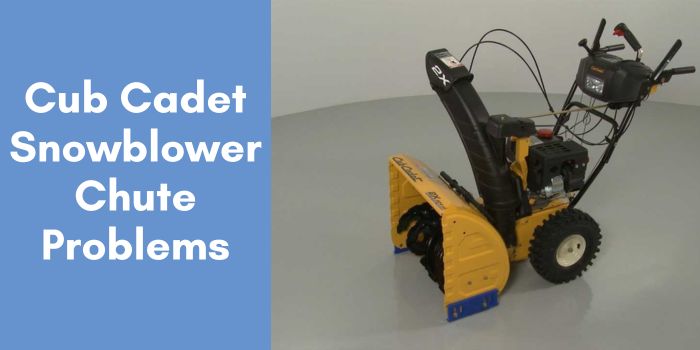Cub Cadet Zero Turn Steering Problems: Expert Solutions
Cub Cadet Zero Turn Steering Problems can be addressed by cleaning the steering system and checking for any worn or damaged parts. Cub Cadet Zero Turn mowers are known for their maneuverability and efficiency in mowing large areas.
However, like any mechanical equipment, they can experience steering problems over time. These problems can range from stiff or unresponsive steering to difficulty in turning the mower in one direction. Fortunately, most steering issues can be resolved with some simple maintenance and troubleshooting steps.
We will discuss some common Cub Cadet Zero Turn steering problems and how to fix them. By following these steps, you can ensure that your mower’s steering system is in optimal condition, allowing for smooth and precise control during your mowing sessions.
Common Steering Problems With Cub Cadet Zero Turn Mowers
Cub Cadet is a well-known brand when it comes to outdoor power equipment, including zero-turn mowers. However, like any machinery, there can be some issues that arise with the steering mechanism.
If you are experiencing steering problems with your Cub Cadet zero-turn mower, it is important to address them promptly to ensure optimal performance and safety.
Let’s dive into some of the most common steering problems you may encounter with these mowers.
Steering Wheel Not Turning Smoothly
One of the most frustrating steering problems that Cub Cadet zero-turn mower owners may encounter is a steering wheel that does not turn smoothly.
This can make maneuvering the mower difficult and hinder its overall performance. When the steering wheel feels stiff, sticky, or requires excessive force to turn, it is a clear indication that there is a problem with the steering system.
Below are some potential causes and solutions to this steering issue:
- Check for debris or obstructions: Inspect the steering system, including the linkages and connections, for any buildup of dirt, grass clippings, or other debris. Clean and remove any obstructions that may be causing the steering wheel to operate less smoothly.
- Lubricate the steering components: Apply a suitable lubricant to the pivot points, joints, and other moving parts of the steering mechanism. This will help reduce friction and ensure smooth operation.
- Inspect the steering belt: The steering wheel is connected to the steering belt, which transfers the movement from the wheel to the mower’s front wheels. Check the belt for any signs of wear or damage and replace if necessary.
Uneven Turning Radius
Another common steering problem with Cub Cadet zero-turn mowers is an uneven turning radius. This means that the mower may not turn equally on both sides, resulting in an unbalanced maneuverability.
Here are a few potential causes and solutions for this steering problem:
- Check tire pressure: Ensure that the tires of your Cub Cadet zero-turn mower are properly inflated to the recommended pressure. Uneven tire pressure can significantly affect the turning radius. Adjust the tire pressure accordingly.
- Inspect the tie rods: The tie rods connect the steering mechanism to the front wheels, allowing them to turn simultaneously. Check for any bent or damaged tie rods and replace if necessary.
- Align the front wheels: Improper wheel alignment can contribute to an uneven turning radius. Adjust the front wheels so that they are properly aligned, ensuring equal turning capabilities on both sides of the mower.
Excessive Play in the Steering Mechanism
Excessive play in the steering mechanism is another steering problem that may occur with Cub Cadet zero-turn mowers.
This refers to the looseness or excessive movement of the steering wheel before it engages the mower’s front wheels. Excessive play can compromise control and make steering imprecise.
Here are some possible causes and solutions to address this issue:
- Tighten loose components: Inspect the steering system for any loose or worn-out components, such as the steering column, linkages, and connections. Tighten or replace these components as needed to reduce play in the steering mechanism.
- Check for worn-out gears: The gears responsible for transferring the steering wheel’s movement to the front wheels may wear out over time. Inspect these gears and replace them if necessary.
- Adjust the steering mechanism: Some Cub Cadet zero-turn mowers allow for adjustments to the steering system. Consult the user manual or contact a professional technician to properly adjust the steering mechanism and eliminate excessive play.
Being aware of these common steering problems with Cub Cadet zero-turn mowers is essential for maintaining optimal performance and maneuverability. Regular maintenance, including cleaning, lubrication, and inspection of the steering system, can help prevent these issues from arising.
Troubleshooting And Fixing Steering Problems
If you own a Cub Cadet zero turn mower, you know that efficient steering is essential for maneuvering around obstacles and ensuring a smooth and precise cut. However, like any mechanical system, the steering on your Cub Cadet may encounter problems over time.
By following these steps, you’ll be back to enjoying a smooth and effortless mowing experience in no time!
Checking the steering system for loose or worn parts
The first step in troubleshooting Cub Cadet zero turn steering problems is to inspect the steering system for any loose or worn parts.
This includes checking the steering wheel, steering controls, and other components for excessive play or damage.
Loose or worn parts can affect steering responsiveness and make it difficult to navigate smoothly. To check for loose parts, gently wiggle the steering wheel and controls while observing for any movement or excessive play.
Inspecting the tie rods and ball joints
Next, you’ll want to inspect the tie rods and ball joints. These components connect the steering wheel to the wheels and are critical for proper steering alignment.
Start by visually inspecting them for any signs of damage or wear. Pay close attention to the rubber boots covering the joints, as they can deteriorate over time and allow dirt and debris to enter. This can lead to premature wear and affect your steering performance.
Examining the steering linkage
Another important step in troubleshooting steering problems is examining the steering linkage. This includes checking the connections between the steering wheel, steering controls, and the steering mechanism.
Look for any loose or misaligned parts, and ensure that all connections are securely fastened. If you notice any damaged or worn components, it may be necessary to replace them to restore proper steering functionality.
Adjusting the steering controls
If you find that your Cub Cadet zero turn mower’s steering is too loose or too tight, adjusting the steering controls may be necessary.
This can usually be done by accessing the adjustment mechanism located near the steering controls. Refer to your owner’s manual or manufacturer’s instructions for the specific adjustment procedure for your model.
By fine-tuning the steering controls, you can achieve the desired responsiveness and ensure comfortable handling during operation.
Correcting the neutral position
The neutral position of your Cub Cadet’s steering system plays a crucial role in maintaining stability and control during operation. If you notice any deviation from the neutral position, it’s important to correct it. This can typically be done by adjusting the linkage or realigning the steering components.
Refer to your owner’s manual or manufacturer’s instructions for detailed steps on correcting the neutral position for your specific model.
Lubricating the steering components
Proper lubrication is vital for maintaining the longevity and smooth operation of your Cub Cadet’s steering system. Over time, the steering components can experience wear and friction, leading to increased resistance and compromised performance. Regular lubrication can help reduce friction and minimize wear, ensuring optimal steering efficiency.
Identifying the areas that require lubrication
Before applying lubrication, it’s essential to identify the specific areas of the steering system that require attention.
This typically includes the pivot points, ball joints, and other moving parts. Visually inspect each component and look for any signs of dryness or excessive wear. These are the areas that will benefit from lubrication.
Using the recommended lubricant
Using the correct type of lubricant is crucial to ensure optimal performance and prevent damage to the steering system.
Different models may require different types of lubricants, such as lithium grease or silicone lubricant. Using the recommended lubricant will help maintain your Cub Cadet’s steering system’s integrity.
Applying the lubricant properly
Once you have the correct lubricant, it’s important to apply it properly to the identified areas. This usually involves using a grease gun or spray lubricant to coat the components evenly.
Pay close attention to the manufacturer’s instructions regarding proper application techniques and quantities.
Over-lubrication can be just as detrimental to the steering system’s performance as under-lubrication, so ensure you apply the lubricant in the recommended amounts.
Replacing worn or damaged steering parts
In some cases, steering problems may be due to worn or damaged parts that require replacement. If you have identified any components that are beyond repair, it’s essential to source the correct replacement parts.
Using incorrect or incompatible parts can lead to further damage and pose a safety risk. Consult your owner’s manual, manufacturer’s recommendations, or contact a trusted dealer to ensure you get the right parts for your specific Cub Cadet model.
Removing the old parts
Before installing the new parts, careful removal of the old ones is essential. Consult your owner’s manual or manufacturer’s instructions for the proper removal procedure for your specific Cub Cadet model.
Take note of any special tools or techniques required and follow the steps precisely to avoid damaging surrounding components.
Installing the new parts correctly
Once the old parts have been successfully removed, it’s time to install the new parts correctly. Carefully follow the manufacturer’s instructions or consult your owner’s manual for step-by-step guidance.
Take your time and ensure that each new component is fitted precisely and securely. Double-check all connections and fasteners before testing the steering to ensure everything is properly aligned and functioning as intended.
Remember to consult your owner’s manual or manufacturer’s instructions for specific guidance tailored to your model. With proper care and maintenance, you’ll be able to enjoy smooth and efficient steering for a long time to come!
Expert Advice For Preventing Steering Issues
If you’re experiencing difficulties with your Cub Cadet’s zero turn steering, don’t panic. Check out our helpful guide from expert.
Operating the zero turn mower correctly
Proper operation of your zero turn mower plays a pivotal role in preventing steering problems. Here are some tips to consider:
- Make sure to read the manufacturer’s manual thoroughly before operating your Cub Cadet zero turn mower. This ensures you have a clear understanding of all the controls and their functions.
- Before each mowing session, visually inspect the steering components, including the steering wheel, linkage, and tires. Ensure there are no loose or damaged parts that could impact the steering.
- Keep the cutting deck at an appropriate height, as poorly adjusted heights can affect the weight distribution and lead to steering imbalances.
Understanding the machine’s turning capabilities
Knowing the turning capabilities of your Cub Cadet zero turn mower is essential for maneuvering efficiently and preventing steering issues. Here’s what you should bear in mind:
| Turning Technique | Description |
|---|---|
| Zero Turn | A zero turn technique involves turning the machine by pivoting it around its rear wheels. This provides exceptional maneuverability and allows you to make sharp turns. |
| Three-Point Turn | In situations where zero turn is not feasible, utilize the three-point turn technique by reversing and turning in a wider radius to change the direction of your mower. |
Using proper driving techniques
Your driving technique influences the machine’s handling and steering responsiveness. Here are some driving tips for smooth steering:
- Maintain a steady and controlled speed when turning to avoid abrupt jerking movements that can strain the steering system.
- Keep a firm grip on the steering controls while mowing, and avoid excessive arm movements that could impact steering stability.
- Use both hands to control the steering levers simultaneously to ensure balanced movement and improved overall control.
Avoiding obstacles and rough terrain
Steering issues can also be caused by rough terrain or collisions with objects. Take note of the following precautions:
- Scan your mowing area before starting to identify potential obstacles such as rocks, tree roots, or uneven terrain that could affect your steering.
- Slow down or change course when approaching obstacles to minimize the impact to the steering system.
- Avoid mowing extremely rough terrains, as excessive vibrations and jolts can negatively affect the steering components over time.
Identifying potential hazards in the mowing area
Lastly, always remain cautious and aware of your mowing surroundings to prevent steering issues caused by unexpected hazards. Consider the following:
- Check for debris, such as branches, stones, or toys, which can get caught in the wheels, potentially interfering with the steering.
- Be mindful of steep slopes or hidden ditches that can strain the steering system or cause the mower to get stuck.
- Stay vigilant and avoid mowing over wet or slippery surfaces that could compromise the traction and steering control of your Cub Cadet zero turn mower.
By following these expert tips, you can maintain optimal steering performance with your Cub Cadet zero turn mower. Preventing steering issues ensures that you enjoy a smooth and efficient mowing experience every time you step on the grass.
Regular Maintenance Tips For A Smooth Steering Experience
If you own a Cub Cadet Zero Turn mower, you know the importance of keeping its steering system in good working condition. Proper maintenance can prevent steering problems and ensure a smooth and effortless ride every time you mow your lawn.
In this section, we will discuss some regular maintenance tips that can help you achieve a great steering experience with your Cub Cadet Zero Turn mower.
Cleaning the Steering Components
One of the first steps in maintaining a smooth steering experience is to keep the steering components clean from dirt and debris.
Over time, these particles can accumulate and affect the performance of your mower’s steering system. Regular cleaning can prevent this buildup and extend the life of your steering components.
Removing Dirt and Debris
To remove dirt and debris from the steering components, start by turning off the engine and engaging the parking brake.
Then, use a brush or compressed air to gently remove any loose particles. Be sure to reach all the nooks and crannies, including the joints and linkages.
Using a Gentle Cleaning Solution
For stubborn dirt or grease, you may need to use a mild cleaning solution. Before applying any solution, make sure to check the manufacturer’s recommendations for cleaning your specific mower model. Use a soft cloth or sponge to apply the solution and gently scrub the affected areas.
Drying the Components Properly
After cleaning, it’s essential to dry the steering components thoroughly to prevent rust or corrosion. Use a clean cloth or towel to remove any excess moisture. Pay extra attention to the concealed areas that may be prone to moisture buildup.
Checking the Tire Pressure
The tire pressure of your Cub Cadet Zero Turn mower can also impact its steering performance. Incorrect tire pressure can cause uneven steering or difficulty in maneuvering. It’s crucial to check the tire pressure regularly and adjust it as needed.
Aligning the Front Wheels
Proper wheel alignment is crucial for optimal steering performance. Misaligned front wheels can cause uneven tire wear and affect the overall control of your Cub Cadet Zero Turn mower. Regularly aligning the front wheels can help prevent such steering problems.
Understanding the Importance of Wheel Alignment
Wheel alignment refers to the adjustment of the toe-in and camber angles of the front wheels. These angles determine how the wheels interact with the ground and affect the steering stability. Correct wheel alignment ensures a smooth and straight mowing experience.
Adjusting the Toe-In and Camber Angles
To adjust the toe-in and camber angles, refer to the owner’s manual for your specific Cub Cadet model. Follow the instructions carefully, making sure to measure and adjust each front wheel separately. This will help maintain proper alignment and improve the steering performance.
Verifying Alignment with a String or Laser Alignment Tool
After adjusting the toe-in and camber angles, it’s essential to verify the alignment. You can use a simple string or a laser alignment tool to check if the front wheels are parallel and straight. This step ensures the accuracy of the alignment adjustments you made.
Frequently Asked Questions
Can Steering Problems Occur In Cub Cadet Zero-Turn Mowers?
Yes, like any other machinery, Cub Cadet zero-turn mowers can experience steering problems. These issues can be caused by various factors such as hydraulic system failures, loose or damaged components, or improper maintenance. It’s essential to diagnose and address these problems promptly to ensure optimal performance and safety.
How Can I Identify Steering Problems In My Cub Cadet Zero-Turn Mower?
Steering problems in Cub Cadet zero-turn mowers can manifest as stiff or unresponsive steering, uneven turns, or jerky movements. If you notice difficulty in maneuvering, excessive play in the steering wheel, or an abnormal noise during operation, it’s likely you’re experiencing steering issues.
A professional inspection and diagnosis are recommended to pinpoint the exact cause and solution.
What Are Common Causes Of Steering Problems In Cub Cadet Zero-Turn Mowers?
Steering problems in Cub Cadet zero-turn mowers can be caused by several factors, including loose or worn-out hydraulic connections, damaged steering linkage, misaligned front wheels, or worn-out steering components. Additionally, inadequate lubrication, debris accumulation, or improper adjustment of the steering system can contribute to steering issues.
How Can I Fix Steering Problems In My Cub Cadet Zero-Turn Mower?
To fix steering problems in your Cub Cadet zero-turn mower, start by inspecting the hydraulic system, checking for leaks or loose connections. Ensure that the steering linkage is in good condition and properly adjusted. If the front wheels are misaligned, realign them following the manufacturer’s instructions.
If the issue persists, consult a professional technician for further diagnosis and repair.
Final Words
All in all, the key to addressing Cub Cadet zero turn steering problems lies in understanding their causes and implementing the appropriate solutions. By regularly maintaining and inspecting your mower’s steering system, you can prevent issues from arising in the first place.
When troubleshooting, be sure to check for loose or damaged parts and adjust the steering controls accordingly. Remember, proactive care and timely repairs will keep your Cub Cadet zero turn mower running smoothly for years to come.




